Suzanne LeClerc (Gabon) and Protas Madlala wed
In South Africa between 1987 and 1993, the National Party entered into bilateral negotiations with the African National Congress (ANC), the leading anti-apartheid political movement, for ending segregation and introducing majority rule. In 1990, prominent ANC figures such as Nelson Mandela were released from prison. Apartheid legislation was repealed on 17 June 1991, leading to multiracial elections in April 1994.
In June 1985, the ban on marriage between people of different ethnic backgrounds was finally lifted. The laws were repealed by the Immorality and Prohibition of Mixed Marriages Amendment Act, which allowed interracial marriages and relationships.
. . .
The Wedding
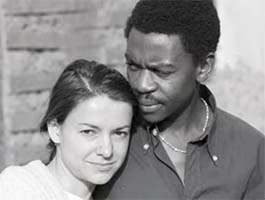
American Suzanne Le Clerc and South African Protas Madlala were the first couple to tie the knot under the new rules.
On the morning of the wedding, Protas Madlala and Suzanne Leclerc (Gabon 1979-82) rode to the church together. It was customary for a bride and groom to arrive separately, but caution prevailed.
Although there had been talk of the South African government relaxing its laws, and an official from the U.S. Embassy had agreed to attend the wedding in case of trouble, as they turned down the passage through the sugar cane fields — a deserted road of blind turns and steep, grass-covered hills, the most likely spot for an ambush— the Zulu groom and his white, American bride were afraid.
But the ambush that awaited was not the one they expected. When they reached the church, they found hundreds of onlookers lining the streets, many cheering and crowding the wedding car. Some had followed gossip overheard hours away in Johannesburg; one news photographer was on a rooftop, angling for a shot of the mixed-race couple about to defy the government and marry.
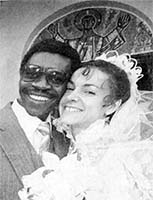
The bride and groom
Suzanne, in a handmade gown she had sewn in secret while staying with nuns in a nearby guesthouse, was struck by a song that rose from the crowd: Africa will be saved. “It wasn’t exactly ‘Here comes the bride,’” she reflected.
At the altar, the couple learned their wedding night would not be spent in prison — the apartheid ban on interracial marriage had been lifted just the night before, in tacit acknowledgement of the couple’s wedding plans. Suzanne and Protas would read about it on the front page of the next morning’s newspapers, alongside the photo that accompanied headlines around the world: On Sunday, June 15, 1985, they were South Africa’s first legally-married interracial couple.
. . .
As a child in Cumberland, Rhode Island, Suzanne had been an adventurer. She spent hours playing pilgrim or building huts in the woods, soaking up stories her father, an appliance business owner and World War II veteran, told her about life on a submarine in the South Pacific. “I knew that someday I wanted to travel,” says Suzanne. “Not just for the sake of it, but to do something while I was there.”
After graduating from high school early, she left home to study health sciences at a community college in Connecticut, then transferred to the University of Rhode Island to major in anthropology. On the second or third day of classes, she sat in a classroom at Chafee Hall and listened as Professor James Loy vocalized the pant hoot of a chimpanzee. “I was so impressed,” says Suzanne.
Not long after earning her degree, she announced to her parents that she was joining the Peace Corps. Her mother was initially perplexed — first the anthropology degree (“She didn’t see jobs in the paper for anthropologists,” says Suzanne), now the Peace Corps, which didn’t seem suitable for a young woman — but ultimately supportive. “My dad was very proud,” Suzanne says. “He thought it was wonderful.”
Suzanne’s Peace Corps years
For two years, Suzanne taught English at a lycee in Gabon, on the west coast of central Africa.
When it was time to return to Rhode Island, Peace Corps administrators asked her to stay in Gabon for a third year to build a school. There were no other women in the construction program, but having spent part of the previous year working with local doctors to collect ethnographic data researching how people managed illness in their families, she was eager for the opportunity to immerse herself further in the local community.
Armed with an instruction manual on how to mix cement and pour a foundation, she hired a crew of nine Gabonese men, making sure to include the native Baka pygmies, whom she had observed as marginalized by the villagers. “Everybody has their prejudices,” she says.
Suzanne still thinks of returning to Gabon, to see if the
school she built still stands. She says, “It’s on my bucket list.”
Meeting Protas
In graduate school, she met Protas. She had returned to the U.S. to study medical anthropology at George Washington University in D.C.; Protas was a student at American University, earning his master’s in international relations and communications. They met through a mutual friend who was living in the basement apartment of the house Suzanne had rented with other students.
Passionate, political — their similarities were striking for a couple that would go on to shock so many with their perceived differences.
Her parents found common ground with their daughter’s boyfriend as well. Suzanne’s father and Protas talked war, politics, history. “The first time I brought Protas home, my father had a big stack of Time magazines for him to read and discuss,” she says.
He passed away before he saw Suzanne marry, but she knew she had his blessing. “He liked Protas very much,” says Suzanne.
The couple had planned to settle in the States, but when Suzanne asked Protas to take her home to South Africa to meet his family before the wedding, plans changed. “He was very involved in the movement against apartheid,” says Suzanne, and everywhere we went, people kept saying, ‘We need him here.’ I felt guilty taking him away.”
By then, Suzanne’s mother was unfazed when she called home to say they had decided to remain in South Africa to marry.
Her mother made the journey to South Africa two months later for the wedding — her first time overseas. “At the wedding, Protas’s family presented her with a big bowl of cow’s blood as an offering of thanks,” says Suzanne. “My mother took it in stride. When reporters asked what she thought of the wedding, she said, ‘Protas is a nice Catholic boy.’ To her, that was the most important thing.”
After the wedding, law did not permit Protas to live outside the black townships. Though interracial sexual relations and cohabitation bans had been repealed, the Group Areas Act— restricting races to live in designated areas — remained. Suzanne was assigned her husband’s legal status (“honorary black,” she says), and the newlyweds lived in a tin-roofed shack in Mariannhill with no electricity or running water, typical conditions in many of the townships that were left to deteriorate by the government in hopes of driving nonwhites out of urban areas to designated rural homelands.
While the villagers embraced the couple (“They were so welcoming and supportive, but they were embarrassed that Protas and I were university graduates living in these conditions”), the streets turned violent at night. “The army would come down the main road, patrolling with their guns,” says Suzanne. Suspected informers were necklaced — a rubber tire shoved down over their shoulders and set on fire — or their houses were burned.
Unable to obtain a work permit or take the black bus to reach town (her legal status only applied to her residence), Suzanne was isolated. Even so, she still finds things to miss about their life on the homestead. “It was a simple life,” she says. “My sister-in-law would wash her clothes outside in the bucket, and I would wash mine next to her, and we would talk. Neighbors would come around. We would make tea on the kerosene stove, eat avocado sandwiches. In many ways, it was a quiet, simple time.”
By the end of the first year, Suzanne moved out of the township to the city then called Umtata (now Mthatha) in the territory of Transkei, one of the designated homelands nearly 250 miles away from Mariannhill, where she had obtained a work permit to teach at the local university.
Protas, whose work as a community organizer was heavily tied to Mariannhill, stayed behind. For the next two years, they saw each other once a month, meeting at a friend’s farm halfway between their homes.
When Suzanne became pregnant with their first child, they were determined to live together, asking around until they found a white woman who agreed to let them stay in hiding in an apartment on her property. With two children who had been involved in the fight against apartheid — a daughter jailed for sending photographs to the press, and a son exiled for organizing trade unions on the docks of the city of Durban — she was willing to take a risk for the young couple.
Suzanne and Protas refused to classify baby Darius race-labelled. They were adamant that accepting race classification meant accepting the systematic degradation that came with it.
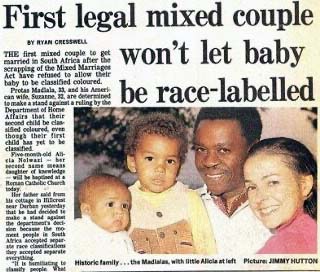
News clipping announcing the couple’s refusal to classify their children.
She remembers her early days of motherhood with some sadness: “I wanted to be a new mother doing new mother things, pushing the baby around in the pram.” Instead, she bundled Darius in blankets to hide his dark skin, sneaking him onto the bus when she occasionally went into the all-white town. “People would look me up and down and gossip,” says Suzanne. “Some recognized me from television. ‘Aren’t you the woman we saw?’ I would say no. Or I would speak French.”
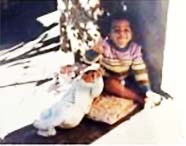
Darius with baby Alicia
At five years old, Darius was killed by a hit-and-run driver in front of their home. Suzanne does not know if it was an accident or deliberate and related to the black chickens that had been tossed into their yard. a the pervading sense they were being watched, retaliation for Protas’s outspoken activism. “The U.S. Embassy looked into it,” says Suzanne, but they were unable to find any conclusive evidence.
She speaks carefully. “It clamps your personality, living in segregation. You don’t feel that you belong in the public space, you don’t feel free. The apartheid system was so successful at keeping those worlds separate, you had these white grannies going on about their lives, talking about their granddaughters taking ballet. They had no idea of the conditions that blacks were living in beyond their suburbs.”
She added: “I felt angry at the government, angry at the people. You couldn’t blame them for wanting to enjoy the sunshine and get on with their lives, but they should have wanted to know about their country and the great injustice going on in their backyard. You can’t just live your nice life — with laser security around the house and killer dogs at the gates. Can you enjoy your life like that?”
The end of apartheid
Apartheid ended in 1994, but the pressures on Suzanne and Protas — social, political, professional — did not. In 2001, they separated.
Adding to tensions, Suzanne had become increasingly worried for the safety of their daughters, four in all: Alicia was born in 1989, then Racquel, Darienne, and the youngest, Saroya.
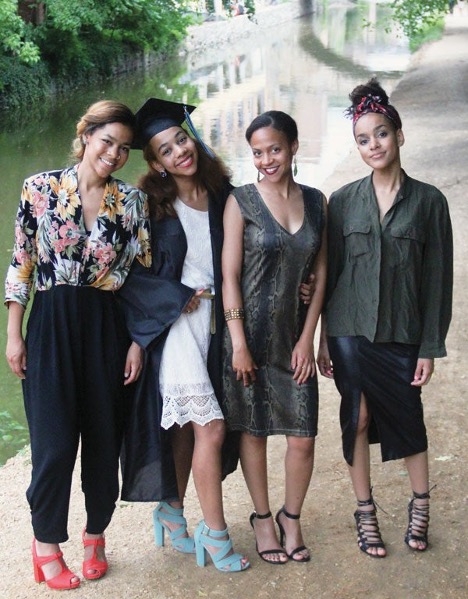
Left to right, Darienne, Saroya, Alicia, and Racquel on the day of Saroya’s graduation from high school.
As a chief research specialist and professor of anthropology at the University of Kwa-Zulu-Natal in Durban, where her work focused heavily on how gender roles and culture were connected to the spread of HIV and AIDS, Suzanne feared the country’s growing climate of sexual violence. “When you have a bigger struggle, all other struggles take a back seat,” says Suzanne. “Once apartheid ended, other issues came to the foreground —gender inequality, violence, criminality — issues that there had been no space for when all energies were focused on fighting against segregation.”
She and Protas questioned whether South Africa, reeling from tensions caused by sudden political change, was the right environment for their young girls. “Alicia would dress as a boy to walk to school because she couldn’t stand the harassment,” Suzanne says. “As a young woman, I had enjoyed exploring and riding my bike freely through the neighborhood — I wanted my daughters to know how that freedom felt.”
In 2009, Suzanne and the girls moved to D.C., where she is now a senior anthropologist for the Global Health Bureau at the U.S. Agency for International Development, addressing the socio-cultural and economic determinants of health. Protas stayed in South Africa, where he is a noted political analyst.
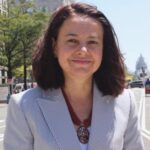
Suzanne Le Clerc (Gabon 1979-82)
Her work still brings her to South Africa, where she remains an external examiner for the University of Kwa-Zulu-Natal. It is a small world: One of her colleagues turned out to be the exiled son of the woman who had rented the apartment to Suzanne and Protas when they left the black township. “I knew about his whole life,” says Suzanne. His name is David. They are now married.
The girls, each in their own way, have followed in their parents’ paths. Darienne left this past October for the Peace Corps. Saroya, an international development major, spent her last semester abroad in Central America. Alicia recently earned her master’s in school counseling, and Racquel works in communications for the National Multifamily Housing Council. “Our parents taught us that it was okay to challenge the status quo,” says Alicia. “The things they did together represent making a big, positive change in the world. We are all trying, in the careers we pursue, to make a difference.”
The girls go back to South Africa to visit their father, and they visit Suzanne’s family in Rhode Island each year, struck by the two worlds.
“When I go to Cumberland, I am always amazed that she met our father and chose to help him with the struggle,” says Alicia. She has imagined the life of her mother: a young woman working in construction with the Peace Corps, a newlywed living in squalor, a first-time mother hiding her newborn baby on the bus. Scrutiny, harassment — even now, fighting for global health — all starting from a childhood in a small town that seems to have changed little since Suzanne was an adventurous girl, riding her bike and hanging on to her father’s stories.
Amazing story. True heroes are those who live lives authentically, and demonstrate love, morals and ethics in spite of obstacles.
Having served in Lesotho from 85-88 at the peak of apartheid, I am amazed at how this couple was able to successfully endure. At that time, South African was a highly controlled police state. Mail coming into Lesotho from home was opened and read by South African security services. Checkpoints throughout South Africa were an impressive gathering of expert forces including sharp shooters in the trees, armed personnel carriers, dogs and machine guns. Signs with “White Only” were common place. Hitch-hiking to Capetown, we had heard that there was free lodging at the local police stations if the jail was empty. So we asked the officer and charge if there was a vacancy, but he said no, because there were no “white cells” available. Yet signs of change were also everywhere. While the older South Africans feared, with some justification, that meddling Communism was being backed by the Russians, they also held deep beliefs that the South African black population was inferior. South African youth and a growing population of moderates, however, had a different view. And almost immediately when the Soviet Union collapsed, and the last justification to protect the status quo had fallen, Nelson Mandela was freed. The rest is history. Amandla Ngawhetu! (Power to the People).
Good information, Matt. Thanks
What an inspirational story. I worked in Gabon with Suzanne in the school construction program, but lost touch with her afterwards. As the first woman serving in the construction program, was a dynamo then, so her trailblazing subsequently is not a surprise; but the magnitude of what she has accomplished is astonishing. She has lived out her ideals as few are willing or capable of doing, and I am in awe.
An amazing story! A very brave girl and couple when they married.
Wowwww!!!! You are truly amazing, Suzanne!!!! I just finished reading your story and found it so stunning and pathbreaking that I read it ever so slowly, staying up after pumpkin hour in Yokohama. I am truly honored to be your friend and have fond memories of you in Franceville in training then in Otala. We had some incredible times!!!! Your daughters are truly gorgeous and seem truly brave and warmhearted as their parents!!! Hope to catch up in an email (ericsan[@]gol.com.Broke with Pear :).